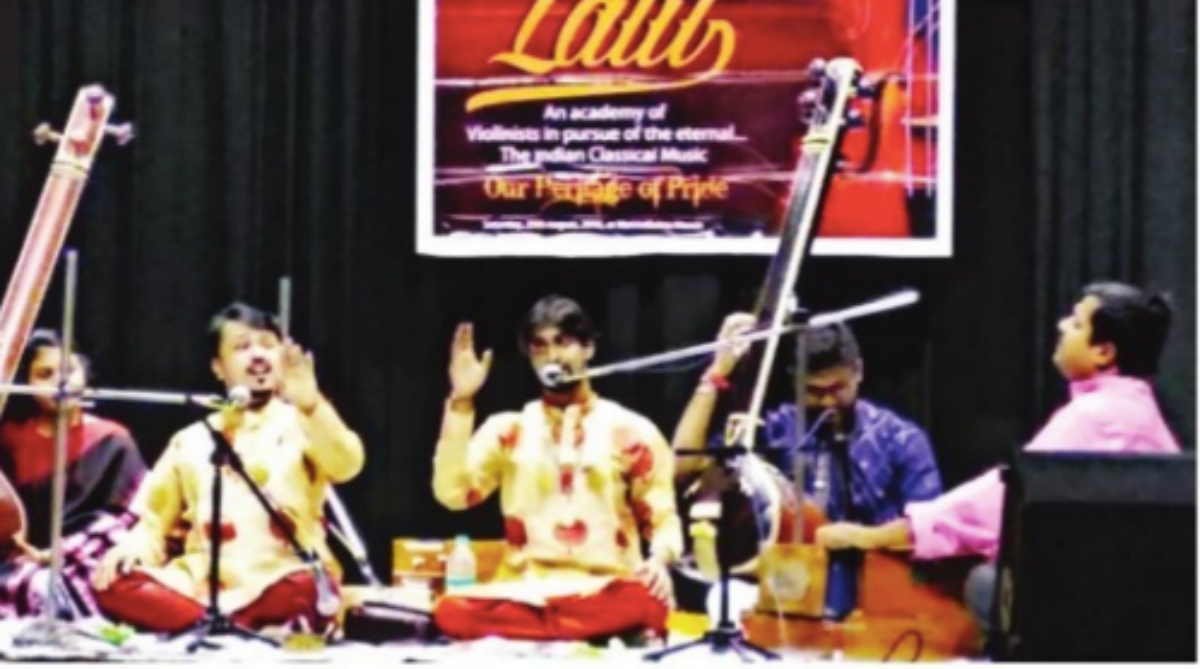Sheer melodic disposition
Being the hub of performing arts, Bengal always organises varied programmes like these, that are sure to soothe connoisseurs minds.
People in cities barely have time for a long session of Padavali Kirtan rooted in mythological stories steeped in one of Indian culture’s most important characteristics — spirituality.

Anirban and Diptam flanked by Surajit Saha (tabla) and Sayan Chatterjee (harmonium)
As is the trend now, most successful musicians are city-products and most reputed soirees are also taking place for city dwellers, who are far away from the age old folklores, which are the base of several precious musical genres. Due to this huge gap, it is becoming more challenging to please and satisfy city dwellers with anything, let alone subtleties of a difficult genre like Bangla Kirtan. People in cities barely have time for a long session of Padavali Kirtan rooted in mythological stories steeped in one of Indian culture’s most important characteristics — spirituality.
The listeners’ already excited minds now look for further excitement. This is taking away a lot of the natural elements from this age-old tradition and replacing them with artificially manufactured ones. But the fact is that Indian music has its roots in Nature and related art forms. A few musicians like Suman Bhattacharya have dedicated their life to revive these dwindling art forms, led by Kirtan, which is a demanding genre that encapsulates classical forms like Prabandh, Dhrupad in different ragas and talas, rich lyrics culled out from classical literature, graceful body movements, impeccable oratory and communicative facial expressions.
As a Kirtankar, Bhattacharya’s grip on all these aspects shine forth due to his deep scholastic and active involvement in both the arenas of performing and teaching. Apart from his venerated status as a faculty member of Viswa Bharati (Shantiniketan), his residence cum academy in Baranagar is famous for organising a Kirtancongregation every year on the auspicious day of Mahalaya. Kudos to Calcutta Performing Arts Foundation for inviting Bhattacharya and his team to showcase their enchanting art of traditional Padavali Kirtanbased on Maan-Bhanjanat Chowdhury House before urban listeners who are drifting away from their roots. The sheer beauty of Bhattacharya’s style and his amazing virtuosity laced by his command over several languages including English (unfortunately, a proof of “education” now) captivated all. Firmly rooted in tradition, he commenced with an invocation.
Advertisement
Before the specific Gaurchandrikaor prelude of the chosen subject of the Pala kirtan, he etched a brief history of the evolution of Vaishnav Padavali Sahitya composed by numerous poets over several hundred years. The devotion-dipped rich verses describe naam,roop,gunand leela of Lord Krishna, which are the four different traps to hook devotees with numerous similes like man-harin(deer like fast moving heart), nayan-khanjan (bird like roving eyes). This Sahitya also encapsulates 64 rasas springing out of milan, viraha and eight types of nayika-bhed. For the demonstration of all these aspects, Bhattacharya selected a variety of raga,tala,genres and verses in different languages (Sanskrit, Bangla, Maithili, Brijbhasha et al). Since Sanskrit has few or no takers, he explained those with the help of some superbly-rendered Tagorean oeuvres. He excelled while describing the pathos ridden mood of raga Darbari in the pure form of dhrupad. Strings attached Among all the string-instruments, violin, a western instrument, is very much like the Indian sarangi, which is quite close to the vocalised form of music. But unfortunately, there are very few competent violinists in the arena of Hindustani classical music.
As such, it is heartening that violinist Tarun Chakraborty is striving to train a host of young violin players at “Lalit”, the Violin Academy. The Academy organised a cultural programme at Mohit Manch (Tala Park) recently. The evening commenced with a violin symphony titled Anandaloke. It was conceived and composed by Chakraborty and presented by his students. It was followed by a violin duet of Sumita Chowdhury and Samson Chakraborty, supported by Sanjib Roy on the tabla. Another jugalbandi followed next, presented by young and upcoming vocalists Anirban Das and Diptam Sinha Biswas, worthy disciples of Pandit Shyamal Lahiri and Vidushi Mandira Lahiri. Their recital included a delightful raga Hameer with khayals in slow and medium paced teental and fast ektal. A Pilu thumri followed next and encores led them to sing a beautiful Raagpradhan composition of Sangeetacharya Chinmay Lahiri. The suitable accompaniment provided by Surajit Saha (tabla) and Sayan Chatterjee (harmonium) added extra zing to their presentation. Finally Tarun Chakraborty, supported by Pandit Sujit Saha on the tabla and Souporno Chakraborty on the violin played raga Hemant. The veterans were at their charming best.
For a cause Santoor maestro Tarun Bhattacharya is associated with several social causes. Along with Odissi danseuse and Guru Sanchita Bhattacharya, he visited one of the orphanages of Howrah recently. They were deeply inspired by the magnitude of the responsibilities shouldered by the home, housing these children and decided to do their bit. Bhattacharya strongly feels that music is the means to return to the future of India all the name and fame he has earned over the decades. As a result, he is on an 18-city concert tour across the length and breadth of the US with a mission “Support a Child”. His forthcoming concert at Los Angeles features a 12-year-old wonder-child Ahilan Hatti, who has been Bhattacharya’s disciple since the age of five. Born and brought up in the US, this child prodigy has also learnt instruments from Paul Livingstone and Rupesh Kotecha and has a great musical future. The entire fund raising initiatives are in aid of 148 orphanages which take care of over 80,000 children across India.
Advertisement